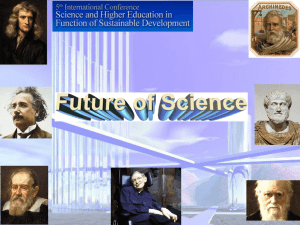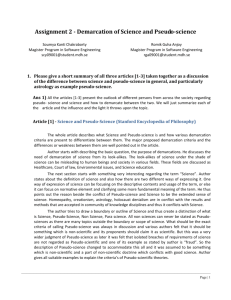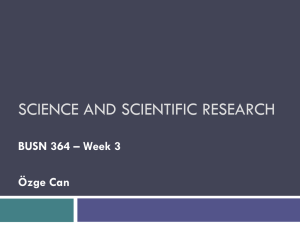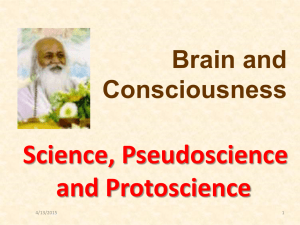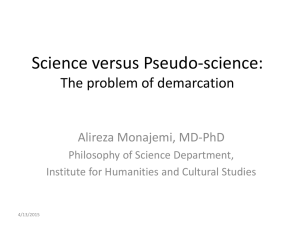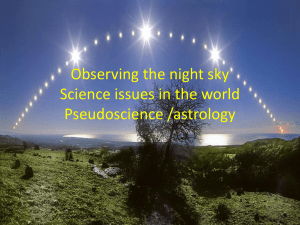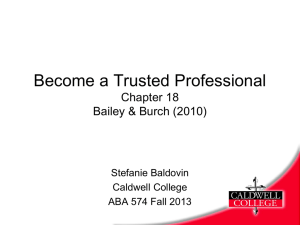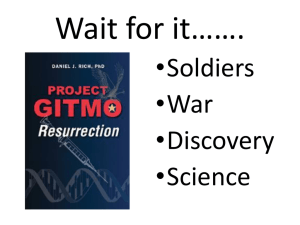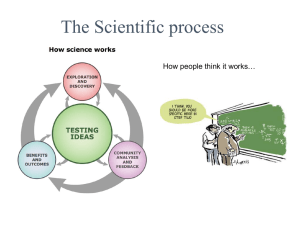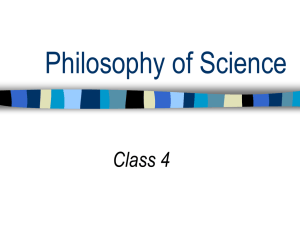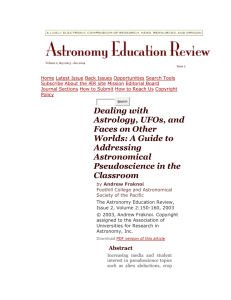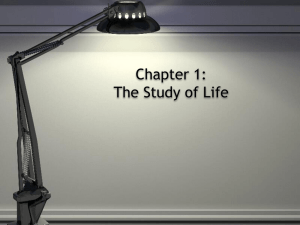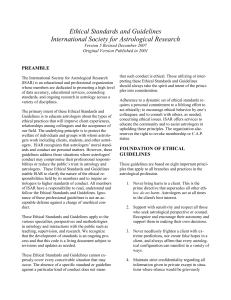Assignment 2 - Demarcation of Science and Pseudo-science
advertisement
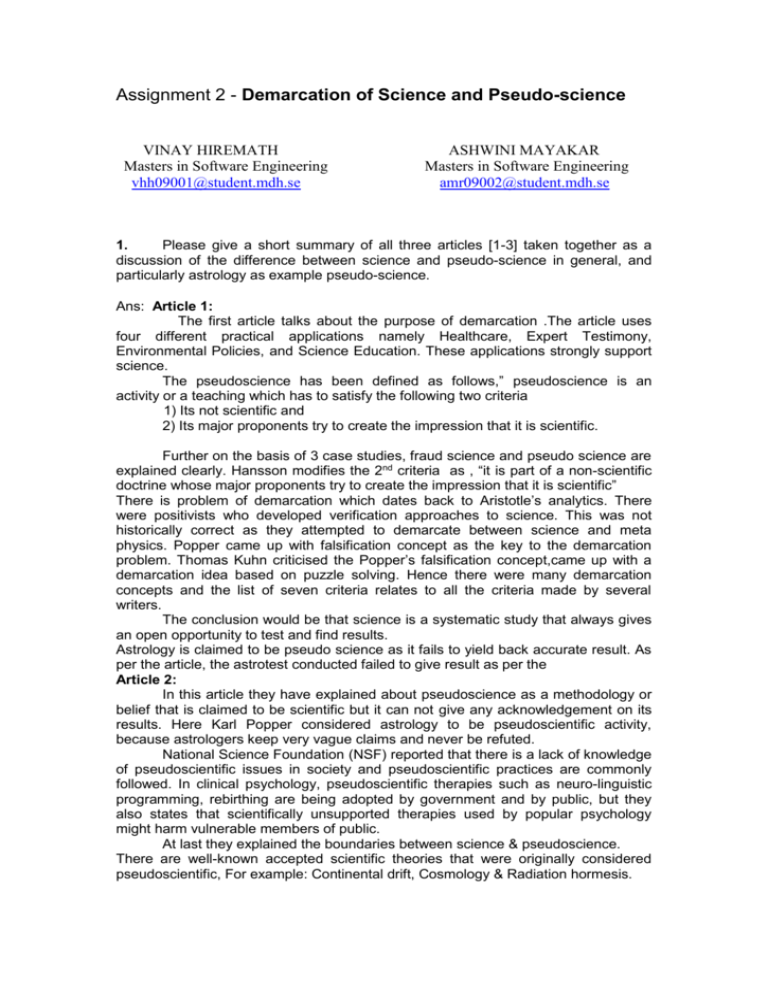
Assignment 2 - Demarcation of Science and Pseudo-science VINAY HIREMATH Masters in Software Engineering vhh09001@student.mdh.se ASHWINI MAYAKAR Masters in Software Engineering amr09002@student.mdh.se 1. Please give a short summary of all three articles [1-3] taken together as a discussion of the difference between science and pseudo-science in general, and particularly astrology as example pseudo-science. Ans: Article 1: The first article talks about the purpose of demarcation .The article uses four different practical applications namely Healthcare, Expert Testimony, Environmental Policies, and Science Education. These applications strongly support science. The pseudoscience has been defined as follows,” pseudoscience is an activity or a teaching which has to satisfy the following two criteria 1) Its not scientific and 2) Its major proponents try to create the impression that it is scientific. Further on the basis of 3 case studies, fraud science and pseudo science are explained clearly. Hansson modifies the 2nd criteria as , “it is part of a non-scientific doctrine whose major proponents try to create the impression that it is scientific” There is problem of demarcation which dates back to Aristotle’s analytics. There were positivists who developed verification approaches to science. This was not historically correct as they attempted to demarcate between science and meta physics. Popper came up with falsification concept as the key to the demarcation problem. Thomas Kuhn criticised the Popper’s falsification concept,came up with a demarcation idea based on puzzle solving. Hence there were many demarcation concepts and the list of seven criteria relates to all the criteria made by several writers. The conclusion would be that science is a systematic study that always gives an open opportunity to test and find results. Astrology is claimed to be pseudo science as it fails to yield back accurate result. As per the article, the astrotest conducted failed to give result as per the Article 2: In this article they have explained about pseudoscience as a methodology or belief that is claimed to be scientific but it can not give any acknowledgement on its results. Here Karl Popper considered astrology to be pseudoscientific activity, because astrologers keep very vague claims and never be refuted. National Science Foundation (NSF) reported that there is a lack of knowledge of pseudoscientific issues in society and pseudoscientific practices are commonly followed. In clinical psychology, pseudoscientific therapies such as neuro-linguistic programming, rebirthing are being adopted by government and by public, but they also states that scientifically unsupported therapies used by popular psychology might harm vulnerable members of public. At last they explained the boundaries between science & pseudoscience. There are well-known accepted scientific theories that were originally considered pseudoscientific, For example: Continental drift, Cosmology & Radiation hormesis. Further they commented that there are some traditional or ancient practices such as “Accupuncture “and “Traditional Chinese Medicine” which are not pseudoscience because their proponents do not claim the practices to be scientific according to today’s standard of scientific method. Article 3: Astrology is a best example for pseudoscience. Here the author Rob Nanninga has clearly explained about astrology and astrotest. The astrologers believe that Sun sign is the only one factor that is influenced by numerous other astrological factors. They came to know that all people with the same sun sign do not have more common characters. Here author arranged one astrotest by inviting all astrologers. All participants received birth data( date, month, year) of 7 anonymous test subjects. They also received seven questionnaires filled out by these subjects. The questions were devised by the participants. They have to match each birth chart with the corresponding questionnaire. To encourage participation author offered 5000 guilders (2500 $) to those who were able to match all seven charts. Response was unexpected more than 70 people participated in it. Finally in the result, the most successful astrologer achieved only three correct matches, whereas half of the participants did not score a single hit. The average number of hits was 0.75. This is 0.25 below the mean change expectation (MCE), a deviation that is not significant. Moreover, there was no evidence that the most experienced astrologers did any better than beginners. 2. Why is it important to distinguish science from non-science? Describe the problem of demarcation and its significance for science according to Sven Ove Hansson’s article [1] Ans: Science is a culture of doubts and has particular methods, which also give s acknowledgement on results, where as non-science is not related with science, for eg: Playing golf, swimming etc. Pseudoscience has no proofs, and does not guarantee on accurate results. Its very important to distinguish science from nonscience because science has proofs and exact results but non-science does not have any proofs. The demarcation problem has been started since from a very long time, the logical positivists suggested a basic idea for a scientific statement could be distinguished from a metaphysical statement in a principle possible to verify. The problem of Demarcation has a history and has been traced back to Aristotle’s Posterior Analytics. The criteria of demarcation was done based on many grounds namely logical positivists verification, falsificationism, puzzle solving. The positivists came up with a verification concept for the demarcation. This was not historically correct as it tried to demarcate science with pseudoscience. Popper described a new concept called falsification. Popper gave scientific status to few pseudoscientific statements. Hence his claim was criticized.Thomas Kuhn made his criteria of puzzle solving.The puzzle solving requires the current theory to be accepted and puzzle to be defined.Astrology is not a science as it does not involves puzzles. Popper disagreed with this statement. According to Popper, astrologers indulge in puzzle-solving and hence astrology should be considered as Science.Lakatos came up with a criteria based on scientific progress. His claim was, “the demarcation criterion should not be applied to an isolated hypothesis or theory but rather to a whole research program that is characterized by a series of theories successively replacing each other”. Science would be progressive if it has more positive results on research field. George proposed that demarcation could be based on the requirement that a scientific discipline be integrated into other sciences. Demarcation criteria was made on epistemic norms where science was characterized as ethos that can be summarized as four sets of institutional imperatives namely universalism, communism, disinterestedness, organized sceptisim. His criteria have often been dismissed by sociologists as oversimplified, and they have only had limited influence in philosophical discussions on the demarcation issue. Most authors who have proposed the criterion for demarcation have put forward a list of criteria. The list has seven areas on which demarcation can be made. . 3. What are the characteristics of pseudoscience according to [2] Ans: The characteristics of pseudoscience are : Practitioners follow a theory but they usually fail to critically evaluate the theory (as in Astrology). Pseudoscience lacks specific measurements and failed to seek an explanation that requires assumptions and operational definitions are not used. Psuedoscience makes use of a language which reveals only a part of fact and is vaguely characterized. Pseudoscience elements argue that skeptics demonstrate beyond a reasonable level and claim the theory to be false. Criteria for deciding pseudoscience: Belief in authority Non–repeatable experiments Handpicked examples ( Benchmarks) Unwillingness to test Disregard of reputing information Proponents of pseudoscientific claims have been found to yield negative results in the field of organic medicine, alternative medicine, naturopathy and mental health. 4. Give a short account of astrotest [3] and its results. Ans: The author,Rob Nanninga decided to offer an Astrotest. He decided the amount 2500$ would be given as price. He wanted to find a solution to the difference of opinions on the issue, “Astrologer can really predict”. The astrotest included the astrologers as participants. The participants will receive the birth data (date, month, year, time) of 7 unknown people referred as test subjects. A set of questions was prepared to be answered by the test subjects. The astrologers will have to match the birth chart with the questionnaire related to the test subjects. The author selected the 7 unknown test subjects initially born in the year 1948. He was informed by president of NGPA that the registered birth times were often rounded off. Hence with this analysis the author selected another set of test subjects. He then used a computer program and calculated the birth charts. The astrologers on an average sent 10 questionnaires to be answered by the test subjects. A set of 25 questions were finalized by the author. The test subjects had to answer 25 questions on several subjects like education, vocation, hobbies etc. Among all questionnaire 24 multiple choice questionnaires were selected by the author taken from the Berkeley personality profile, with the opinion of 8 experienced astrologers. The astrologers were given a span of 10 weeks to accomplish the tasks. Results were not as expected by the author. About 44 experienced astrologers completed the test. The most successful astrologer achieved 3 correct matches, where as 50% did not have single hit. The author explains the possibilities of showing the selected combinations with help of a chart. According to the charts there were 49 possible combinations none was selected more that 12 times. There were only 2 astrologers with same entries. Many failed to explain why their prediction went wrong .Many of them said that the information was not sufficient to make the predictions. 5. What are your conclusions on science contra pseudo-science discussion? Ans: The discussion was interesting as it was interactive. The most interesting part of the discussion was Astrology. Astrology is considered to be pseudoscience as it fails to produce any accurate details. It cannot give results as per the scientific requirements. Astrology is a nice way of counseling and astrologers also insist on the personal satisfaction of their customers. This eventually becomes a good reason for them to escape from the questions of science. There is no single procedure for all astrologers in common to follow. Science has always a systematic way towards knowledge and is open for any person to test and fine results. Solving every day’s problem is Science. Hence as we study more on science, the more we experiment and try to find results. There are many other fields that are considered to be pseudoscience like homeopathy, creationism. Science gives proofs and acknowledges the results where as pseudoscience does not give any proofs and acknowledges. Pseudoscience is not a science; tries to pretend it is scientific. Eg: Astrology. We also discussed about religion and science. Science is a culture of doubts where as Religion is culture of trusts. We can not test in religion we can only trust, where as we can both trust and test in Science.
